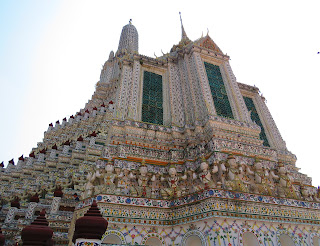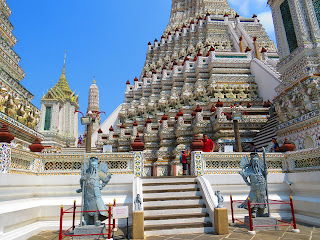Wat Arun - The Temple of Dawn - Bangkok
Thailand and Bangkok
Thailand, officially called the Kingdom of Thailand, is a small South East Asian country located near Myanmar and Cambodia. It was formerly known as Siam.
Though Thailand is officially a constitutional monarchy, whereby the prime minister is the head of government and a hereditary monarch is the head of state, it is actually under the control of a military junta.
Thailand has been heavily influenced by the culture of India for several centuries. It is evident from the Indianised names of the kingdoms, cities, and even the Kings. Ramayana, the epic from India, is very popular in Thailand.
Bangkok, known as Krung Thep Maha Nakhon in the Thai language, is the most populous capital of Thailand. It is famous for its vibrant street life, ornate temples, massage parlors, and shopping.
The Temple of Dawn
Wat Arun Ratchawararam or Wat Chaeng!
Well, it's challenging to remember or pronounce either of the above names. That's why we call this site the Temple of Dawn in English or simply Wat Arun in Thai. This is one of the most spectacular and famous temples in Bangkok. More than that, the temple is unique in architectural design.
Located on the west banks of the Chao Phrava, this temple is named after Lord Arun. Arun is the charioteer of Lord Surya (the Sun God). He represents dawn. Hence, the site is also called the temple of dawn.
This temple was the Emerald Buddha's home before moving to the Grand Palace.
The temple is open for the entire day from 8:30 am to 5:30 pm. The entry fee for foreigners is 100 baht, which is nominal compared to the price collected for other famous temples in Bangkok. This temple can be reached either by road or by boat from the other side of the river.
History
On this site, there stood an Ayutthaya-period temple named Wat Makok. After the destruction of Ayutthaya, the capital city, by the Burmese in 1767 CE, King Taksin, the only King of the Thonburi dynasty, arrived at this old temple. It is believed that he reached the site when the dawn was just breaking. He formed his new capital Thonburi on the west banks of the river Chao Phraya and also built a new temple named Wat Jaeng on the remains of the old temple. Thus, the temple predates the founding of Bangkok city. (Bangkok was founded only in 1782).
Thonburi had this temple as a royal and private temple and built his palace around it, as the site was the first place to get the morning sunlight. It is said that he expelled the Buddhist monks from the temple.
Takshin was dethroned in a coup and was ultimately killed in 1782. The era of the Rattanokosin kingdom began. They established Bangkok on the other side of the river as the new capital. King Rama I of the Chakri dynasty allowed the monks to reenter the temple. During the period of King Rama II, the temple was renovated and renamed as Wat Arun Rachataram.
King Rama III built the tallest prang in the temple's enclosure and renamed the temple as Wat Arun Ratchawararam.
Tallest Prang
The tallest prang (spire) of Wat Arun temple that dominates the skyline around the river is a spectacular sight. This tallest tower in Thailand remains one of the city's famous landmarks. Wat Arun temple became famous due to this prang. (A prang is architecturally different from a stupa. Few writers use the terms interchangeably, which is not correct).
 |
| Prang |
The prang is around 66.8 meters high and is decorated with tiny pieces of colored glass and Chinese porcelain. Rama III, who extended the prang, added these decorations in the middle of the 19th century CE. The steps to reach the prang are very steep. Nowadays, visitors are allowed only until the middle level for security reasons.
 |
| Yakshas |
The tower is built based on Khmer architectural style. The tower is decorated with ceramic tiles and fragments of multicolored porcelain to make it a colorful and stunning monument. (It is said that the Chinese ships dumped a load of excess porcelain into the river of Bangkok in those days, which was recycled and used to decorate the temples.) It is believed that this grand prang represents Mount Meru.
 |
| Kinnaras |
The entrance is guarded by the statues of two giant Chinese soldiers. The sculptures of Chinese figures and animals are found at the tower's base. The topmost portion of the tower has the King's crown, which was placed by King Rama III. Four images of Indra seated on a three-headed Erawan facing four different directions are found in the middle layer. Of course, we cannot see that. All these layers at various levels are supported by numerous half-human Kinnaras and the frightening Yakshas.
 |
| Prang |
The grand prang is surrounded by four smaller prangs. Like the figure of Indra in the central tower, each of these smaller towers has four statues of Phra Phai (Vayu or the Wind God) seated on a horse facing four different directions.
Four sub-shrines around the central tower enshrine the images depicting birth, the first sermon in Sarnath, enlightenment, and nirvana.
 |
| Indra |
 |
| Vayu |
Ordination Hall
 |
| Ordination Hall |
 |
| Niramitr Buddha |
 |
| Lord Arun |
 |
| Buddha with the subduing Mara Mudra |
Buddha's footprint carved in a kind of stone called Kwatong stone is enshrined in a shrine. It is located in an elevated mondopa which can be reached only through a flight of steps. Large bells are found near the shrine. A beautiful garden is situated facing this shrine.
 |
| Shrine with Buddha's Footprint |
King
 |
| King's Statue |













.JPG)
Comments
Post a Comment